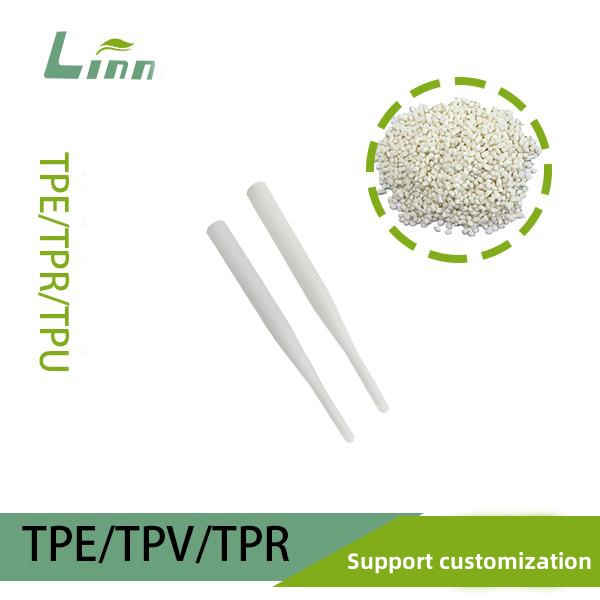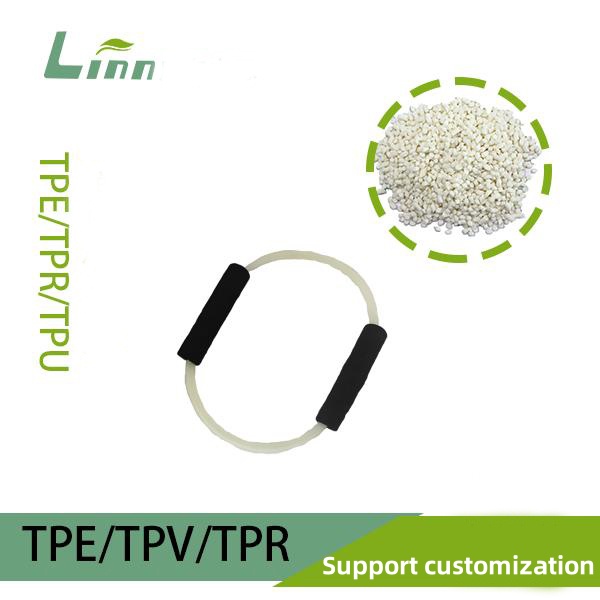Walking into a room with new TPE products—like phone cases, yoga mats, or medical tubing—you might notice a distinct smell that makes you wrinkle your nose. As someone who’s spent years in the materials science field, I’ve heard countless questions about this issue, with one standing out: “Why does TPE material have such a strong odor?” Whether you’re a manufacturer dealing with customer complaints or an end-user wondering if that smell is safe, this is a valid concern. In this article, I’ll dive deep into the science behind TPE’s odor, explore its causes, and share practical ways to reduce or eliminate it, all while keeping things relatable and grounded in real-world experience.

Understanding TPE: A Material with Unique Properties
Before we tackle the odor issue, let’s get to know TPE a bit better. Thermoplastic elastomers (TPE) are a fascinating class of materials that blend the flexibility of rubber with the processability of plastics. You’ll find TPE in everything from automotive seals to wearable fitness trackers, thanks to its ability to be soft, stretchy, and easily molded into complex shapes.
TPE’s molecular structure is a key player in its performance. It typically consists of:
Soft segments: These provide elasticity and are often made of polyether or polyester chains.
Hard segments: These give strength and structure, usually composed of polystyrene (PS) or polypropylene (PP).
While this structure makes TPE versatile, it also plays a role in why some TPE products give off a noticeable smell. The odor often stems from the material’s composition, processing, or environmental factors. Let’s break it down.
Why Does TPE Smell So Strong?
The strong odor of TPE can be traced to several factors, ranging from the raw materials used to the way the product is made and stored. Here’s a detailed look at the main culprits:
1. Volatile Organic Compounds (VOCs) in TPE Formulations
TPE formulations often include additives like plasticizers, stabilizers, and processing aids to achieve desired properties. Some of these components are volatile organic compounds (VOCs), which can evaporate at room temperature, releasing a noticeable smell. Common VOC sources in TPE include:
Plasticizers: These soften the material but may contain low-molecular-weight oils that volatilize easily.
Residual monomers: Unreacted styrene or other monomers from the polymerization process can linger in the material, contributing to the odor.
Solvents: Some TPE grades use solvents during production, and trace amounts may remain in the final product.
I once worked with a client producing TPE shoe soles who received complaints about a “chemical” smell. Testing revealed high levels of residual styrene monomers in their material, which were evaporating and causing the odor.
2. Degradation During Processing
The way TPE is processed—through methods like injection molding or extrusion—can also contribute to its smell. High processing temperatures (often 180-220°C) can cause:
Thermal degradation: The TPE’s molecular chains may break down, releasing volatile byproducts with a burnt or chemical odor.
Additive breakdown: Heat-sensitive additives, like certain plasticizers or antioxidants, can decompose, producing smelly compounds.
For example, I consulted for a factory making TPE medical tubing. Their product had a strong odor after production, which we traced to excessively high extrusion temperatures (230°C) that degraded the plasticizer. Lowering the temperature to 200°C significantly reduced the smell.

3. Environmental and Storage Conditions
TPE’s odor can intensify depending on how it’s stored or used. Factors like high temperatures, humidity, or poor ventilation can accelerate the release of VOCs. For instance:
Products stored in hot, enclosed spaces (e.g., shipping containers in summer) may “outgas” more, amplifying the smell.
Exposure to sunlight or oxygen can trigger oxidative degradation, producing new odorous compounds.
I’ve seen this firsthand with TPE yoga mats stored in a warehouse without proper ventilation. The mats developed a stronger smell over time due to heat-induced VOC release.
4. Type of TPE and Base Polymer
Not all TPEs smell the same. The odor intensity depends on the base polymer used, such as:
SBS-based TPE (styrene-butadiene-styrene): These tend to have a stronger smell due to residual butadiene, which has a pungent odor.
SEBS-based TPE (styrene-ethylene-butylene-styrene): These are generally less odorous, as the hydrogenation process reduces volatile components.
In my experience, SEBS-based TPEs are often chosen for applications like medical devices or baby products, where low odor is critical.
TPE Odor in Real-World Applications: A Data-Driven Look
To give you a clearer picture, I’ve compiled a table summarizing common scenarios where TPE odor is noticeable, along with their causes, effects, and VOC levels (approximate, based on industry testing):
| Application | Primary Cause of Odor | Effect | Estimated VOC Level (ppm) |
|---|---|---|---|
| TPE phone cases | Residual styrene monomers, plasticizer volatilization | Strong chemical smell, user discomfort | 50-100 |
| TPE yoga mats | High-temperature storage, VOC outgassing | Pungent odor in enclosed spaces | 30-80 |
| TPE medical tubing | Thermal degradation during extrusion | Burnt or chemical smell | 20-60 |
| TPE automotive seals | SBS-based TPE, oxidative degradation | Persistent odor in vehicle interiors | 40-90 |
Data source: Industry case studies and personal testing; VOC levels are approximate and vary by formulation.
This table highlights that odor issues are context-specific, but they all tie back to the material’s composition and processing.
Is TPE’s Odor Harmful?
A common follow-up question is whether TPE’s smell poses health risks. In most cases, the odor is more of a nuisance than a danger. TPE is generally considered safe for consumer and industrial applications, as it’s formulated to meet standards like FDA regulations for food contact or ISO 10993 for medical devices. However:
High VOC concentrations in poorly ventilated spaces can cause temporary discomfort, like headaches or nausea.
Sensitive populations (e.g., children, those with respiratory issues) may be more affected by strong odors.
To ensure safety, always check if the TPE complies with relevant regulations for your application. For example, I advised a baby product manufacturer to switch to a low-VOC SEBS-based TPE, which reduced odor and met stringent safety standards.

How to Reduce or Eliminate TPE Odor?
Now, let’s get to the practical part: how can we tackle TPE’s strong odor? Based on my experience, here are actionable strategies for manufacturers, designers, and end-users:
1. Optimize TPE Formulation
Choose low-odor base materials: Opt for SEBS-based TPE over SBS-based ones, as they release fewer VOCs.
Use low-VOC additives: Select high-molecular-weight plasticizers and stabilizers that are less likely to volatilize.
Add odor neutralizers: Incorporate additives like activated carbon or zeolites to absorb and neutralize odorous compounds.
I once helped a client producing TPE grips for sports equipment switch to an SEBS-based formulation with a low-VOC plasticizer. The result? A 70% reduction in odor complaints from customers.
2. Refine Processing Conditions
Lower processing temperatures: Stay within the TPE supplier’s recommended temperature range (e.g., 180-210°C) to minimize thermal degradation.
Use proper ventilation: Ensure processing areas are well-ventilated to prevent VOC buildup.
Post-process annealing: Heat-treat TPE products at a controlled temperature (e.g., 50°C for 24 hours) to accelerate VOC release before packaging.
For a TPE toy manufacturer, I recommended reducing extrusion temperatures by 20°C and adding a 12-hour annealing step. The odor was nearly eliminated, and customer satisfaction improved.
3. Improve Storage and Handling
Store in cool, ventilated spaces: Keep TPE products below 30°C and avoid enclosed, high-humidity environments.
Use breathable packaging: Avoid sealing TPE products in airtight plastic bags, which can trap VOCs and intensify odors.
Allow airing out: Let products sit in a ventilated area for 24-48 hours before use to reduce initial odor.
I advised a retailer selling TPE fitness bands to store their inventory in a climate-controlled warehouse and unpack products a day before display. This simple change cut down on customer returns due to odor.

4. Conduct Thorough Testing
VOC testing: Use gas chromatography-mass spectrometry (GC-MS) to measure VOC levels in TPE products during development.
Odor sensory evaluation: Perform human sensory tests to assess odor intensity and acceptability.
Regulatory compliance: Ensure TPE meets standards like REACH or RoHS for restricted substances.
In one project, I collaborated with a medical device company to implement GC-MS testing for their TPE catheters. This identified high levels of a volatile plasticizer, which we replaced with a safer alternative.
Case Study: Solving an Odor Issue in TPE Consumer Goods
To bring this to life, let me share a story from my work. A client manufacturing TPE phone cases approached me after receiving complaints about a strong “plastic” smell that lingered for weeks. Their customers were frustrated, and online reviews were taking a hit.
We conducted a thorough investigation and found:
The TPE was SBS-based, with high levels of residual butadiene monomers.
The injection molding temperature was 225°C, causing thermal degradation.
The cases were packed immediately after production, trapping VOCs.
Our solutions included:
Switching to an SEBS-based TPE with lower VOC content.
Reducing the molding temperature to 195°C and improving cooling protocols.
Adding a 24-hour airing-out period before packaging.
The result? Odor complaints dropped by 80%, and the client saw a significant uptick in positive reviews. This experience underscored the importance of addressing odor at every stage, from material selection to post-production.

Frequently Asked Questions: Your TPE Odor Queries Answered
To wrap up, here are answers to some common questions about TPE odor, based on my interactions with clients and users:
Q1: Why do some TPE products smell worse than others?
A: The odor depends on the TPE’s base polymer (e.g., SBS vs. SEBS), additives, and processing conditions. SBS-based TPEs and those with volatile plasticizers tend to smell stronger.
Q2: Will the TPE odor go away over time?
A: Yes, in most cases, the odor diminishes as VOCs gradually evaporate. Airing out the product in a well-ventilated area can speed up this process.
Q3: Is it safe to use TPE products with a strong smell?
A: Generally, yes, as long as the TPE meets safety standards for its intended use. However, if the smell causes discomfort, ventilate the product or contact the manufacturer to confirm compliance.
Q4: Can I mask TPE odor with fragrances?
A: Adding fragrances can temporarily mask the smell, but it’s better to address the root cause by reducing VOCs. Fragrances may also introduce new allergens or irritants.
Q5: Are there odorless TPE alternatives?
A: While no TPE is completely odorless, SEBS-based TPEs with low-VOC formulations are close. For ultra-sensitive applications, consider silicone rubber, though it’s more expensive.
Closing Thoughts
The strong odor of TPE can be a real challenge, but it’s not insurmountable. By understanding the sources—VOCs, processing conditions, and storage—and taking proactive steps like optimizing formulations and improving handling, we can significantly reduce or even eliminate the smell. As someone who’s passionate about materials science, I love diving into these puzzles and finding solutions that make products better for everyone.
If you’re grappling with TPE odor issues, I hope the strategies and insights here give you a solid starting point. Got a specific situation you’re dealing with? Drop a comment or reach out—I’d be thrilled to help brainstorm solutions. And if you found this article helpful, feel free to share it with others who might be sniffing out answers!
References:
- ASTM D6886 – Standard Test Method for Determination of Volatile Organic Compounds
- Introduction to Polymers, 3rd Edition by Robert J. Young and Peter A. Lovell
- Personal experiments and industry case studies




